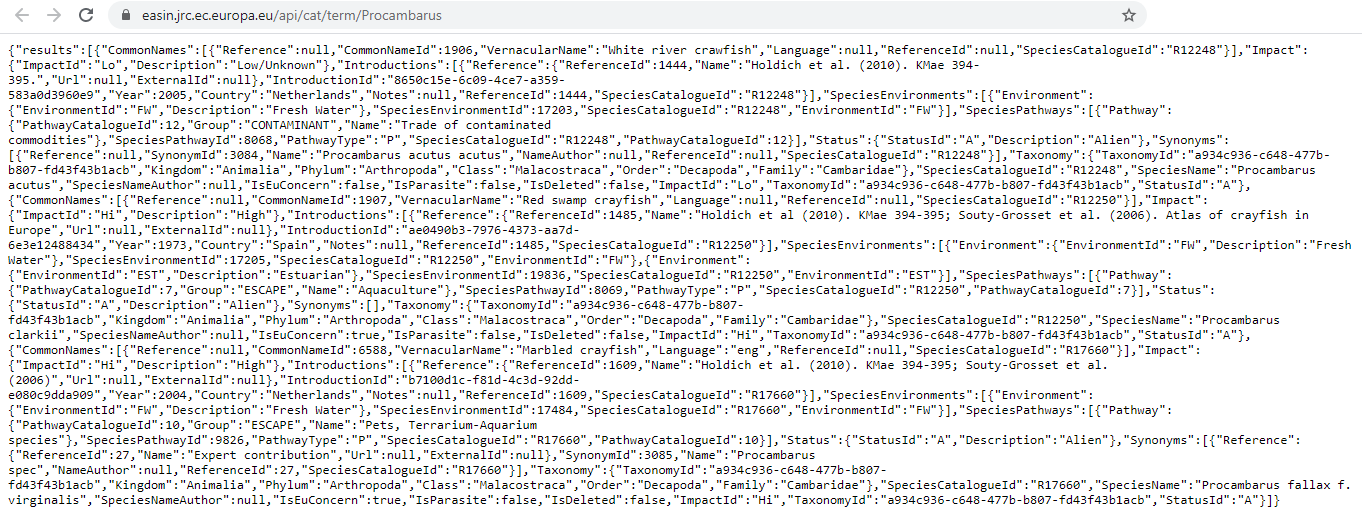The EASIN RESTful Web Services enable users to query and retrieve species information from the EASIN Catalogue in the form of JSON objects, and occurrences geospatial information from the EASIN Geo Database; the latter is provided in the form of Well Known Text geometries contained within JSON objects.
The services main web page is at https://alien.jrc.ec.europa.eu/api
Catalogue Web Services
The users can select records by species scientific name, their environment, impact, taxonomy, or species of Union concern (LegalFramework).
The base URL for all the catalogue web services calls is https://alien.jrc.ec.europa.eu/api/cat
A skip/take mechanism allows the retrieval of records in subsets, facilitating the process when large numbers of records result from a specific query. Examples of how the skip/take mechanism works can be found on "Instructions for using the EASIN RESTful web services" under "Catalogue Web Services".
Geospatial Web Services
The users can retrieve information per single species ID (EASIN ID) on the species factsheets in the EASIN catalogue by searching for desired species and expanding their data section.
The base URL for all the geospatial web services calls is https://alien.jrc.ec.europa.eu/api/geo
The skip/take mechanism is used to obtain paginated results, improving the service performance and providing the users with a more usable output.
The layer type has to be specified in the URL https://alien.jrc.ec.europa.eu/api/geo/speciesid/{speciesid}/layertype/{layertype}/take/{take}/skip/{skip} by using layertype/cntr for country level geometries or layertype/grid to get the geometries in the form of EEA 10x10Km grid.
An example of how the skip/take mechanism works can be found on "Instructions for using the EASIN RESTful web services" under "Geospatial Web Services"
Catalogue Web Services
It is possible to filter and retrieve species by:
Term
Replace the {term} with the species scientific name or part of it. It may lead to zero or more results. The minimum number of characters to start the search is three.
Environment
Replace the {environment} with one of the abbreviations MAR or FW or TER or EST to filter species by, marine, freshwater, terrestrial or estuarine environments respectively.
Species of Union Concern
Species of Union Concern: retrieves all the species of Union Concern.
Impact
Replace {impact} with “hi” to select species with high impact, or “lo” to select species low or unknown impact.
Taxonomy (single level)
Substitute {taxa} with Kingdom, Phylum, Class, Order or Family, and {taxa name} with the respective taxa names of interest.
Taxonomy (full)
Follows the same logic as for taxonomy single level, by adding the additional taxonomic levels and names to the search path.
By Specific Country
Species can be searched for specific Country of presence (species which are present 'at least' in the selected Country, not Country-exclusive species). Please note in this case only the base path is different: apixg/catxt instead of api/cat.
Here is the list of possible Country codes.
Geospatial Web Services
By single species and layer type
Replace {speciesid} with the species’ EASIN catalogue ID and the {layertype} with either ‘cntr’ to get the Country layers or the ‘grid’ to get the grid layer.
Example: https://alien.jrc.ec.europa.eu//api/geo/speciesid/R02476/layertype/grid/take/10/skip/0
The resulting JSON is mainly intended to be used as a data transfer format, to enable machine-to-machine interaction, or as a base format to download and transform in tabular or human readable format.
There are several online tools available to users to convert the query results (JSON data) in commonly used formats, e.g. CSV, Excel. For instance:
1. Type the link https://alien.jrc.ec.europa.eu/api/cat/term/{term} on your browser.
2. Substitute the {term} with a species scientific name or part of the name, e.g. https://alien.jrc.ec.europa.eu/api/cat/term/Procambarus; press enter.
3. The above query, when run in Firefox, would return the result (by default) as depicted in figure 1. In this example, seven species were found (0 to 6), For each species, the service allows the extraction of species common names, impact, year and country of first introduction, environment, pathways of introduction taxonomy, etc, shown collapsed in figure 1. Information concerning species number 6 is presented in expanded view. The web service output might be displayed as easin Figure 2, which is the default output when the service is run in Chrome.
4. Copy and paste the result in one of the following tools:
Download: Pdf format

